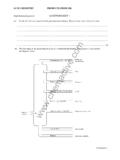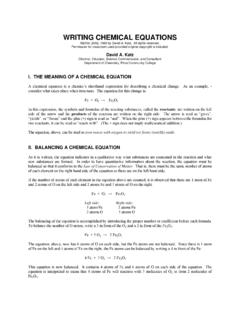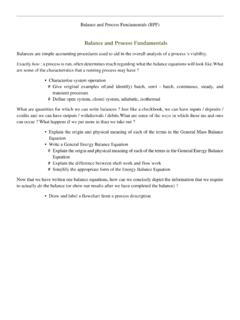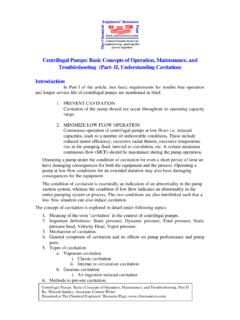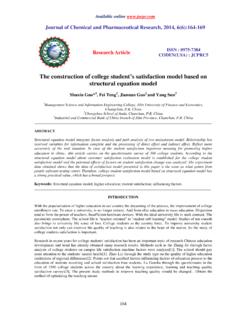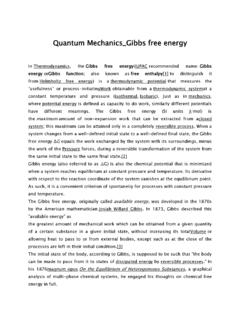Transcription of www.chemactive
1 CHEMISTRY ELECTRICITY IN CHEMISTRY High Demand Questions QUESTIONSHEET 1 Aluminium is manufactured by the electrolysis of molten aluminium oxide which is obtained from the ore bauxite. (i) Explain why the aluminium has to be in the molten form for the electrolysis to take place.. [1] (ii) Pure aluminium oxide melts at 2045oC. Name the substance to which the aluminium oxide is added in order that the melting point is reduced to below 1000oC.. [1] (iii) Explain the reason why aluminium is extracted from its oxide by means of electrolysis rather than a chemical reducing agent such as carbon.
2 [1] (iv) Name the substance that the positive electrode is made of.. [1] (v) Name the gas given off at the positive electrode.. [1] (vi) Give a balanced symbol equation for the reactions taking place at the positive and negative electrode. I. At the positive electrode.. II. At the negative electrode.. [4] (vii) Explain why the positive electrodes must be replaced on a regular basis.. [2] TOTAL / 11 CHEMISTRY ELECTRCITY IN CHEMISTRY High Demand Questions QUESTIONSHEET 2 The following diagram shows the apparatus that could be used to investigate the electrolysis of molten lead(II) bromide.
3 Molten lead(II) bromide is an electrolyte. Both electrodes are made from graphite. (i) Give the meaning of the terms: I. electrode .. II. electrolyte .. [2] (ii) State why the dish was heated during the experiment.. [1] (iii) Give the symbols for the two ions present in the molten lead bromide.. [2] (iv) Give the colour of the vapour released around the positive electrode.. [1] ( ) battery negative electrodepositive electrode lead bubbles of gasmolten lead bromide dish heat and CHEMISTRY ELECTRICITY IN CHEMISTRY QUESTIONSHEET 2 CONTINUED (v) The word equation for the reaction that took place at the negative is: lead ion + electrons lead atom Give the balanced symbol equation for this reaction.
4 [2] (vi) This experiment can be repeated using different substances. Predict the products of electrolysis of the following two molten compounds by completing the table. Molten compound Produced at the positive electrode Produced at the negative electrode Sodium chloride Lithium sulphide [2] TOTAL / 10 CHEMISTRY ELECTRCITY IN CHEMISTRY High Demand Questions QUESTIONSHEET 3 If two different metals are placed in salt solution, electricity can be made as shown.
5 (a) Name two metals which, when used in the apparatus, would give a reading on the voltmeter.. [2] (b) What everyday use is made of this process? .. [1] (c) How can this experiment be used to work out a reactivity series of metals? .. [2] (d) Why does this process eventually stop working? .. [1] (e) List three ways in which the voltage of the cell could be increased.. [3] TOTAL / 9 V Metal A Metal B CHEMISTRY ELECTRICITY IN CHEMISTRY High Demand Questions QUESTIONSHEET 4 The chemical A is sodium chloride.
6 (a) Write the formula for A.. [1] (b) When electricity is passed though A, what is produced at (i) the anode? .. [1] (ii) the cathode? .. [1] (c) Write a half equation showing the reaction at (i) the anode.. [2] (ii) the cathode.. [2] (d) (i) If A were molten, what mass of chlorine would be produced if g of sodium were formed? .. [3] (ii) What volume will this gas occupy at room temperature? (The molar volume of a gas at room temperature is 24 dm3).
7 [2] TOTAL / 12 A CHEMISTRY ELECTRCITY IN CHEMISTRY High Demand Questions QUESTIONSHEET 5 The diagram shows electricity being passed into sodium chloride solution. (a) Give the names of gas A and gas B. Gas A.. Gas [2] (b) What four ions are present in sodium chloride solution? .. [2] (c) Use equations to explain what happens (i) at the anode.
8 [2] (ii) at the cathode .. [2] TOTAL / 8 + + --Gas BGas ABrine in Sodium hydroxide solution CHEMISTRY ELECTRICITY IN CHEMISTRY High Demand Questions QUESTIONSHEET 6 Electricity is passed through molten sodium chloride. (a) What ions are present in molten sodium chloride? .. [2] (b) Use equations to explain what happens (i) at the anode .. [2] (ii) at the cathode .. [2] (c) What is the safety problem with this experiment?
9 [1] TOTAL / 7 CHEMISTRY ELECTRCITY IN CHEMISTRY High Demand Questions QUESTIONSHEET 7 Electricity is passed into nickel nitrate solution using nickel electrodes as shown in the diagram. (a) Give the formulae of all the ions that are in nickel nitrate solution.. [2] (b) Write an equation for the deposition of nickel ions at the cathode.. [1] (c) g of nickel was deposited in 60 minutes with a current of A. (i) Calculate the quantity of electricity in coulombs.
10 [1] (ii) How much electricity is needed to deposit 1 mole of nickel (59 g)? .. [2] TOTAL / 6 - + Nickel nitrate solution CHEMISTRY ELECTRICITY IN CHEMISTRY High Demand Questions QUESTIONSHEET 8 The diagram shows how aluminium can be manufactured by electricity. (a) What is the formula of aluminium oxide? .. [1] (b) Why is the aluminium oxide dissolved in cryolite? .. [1] (c) Write the equation for what happens at the cathode.
